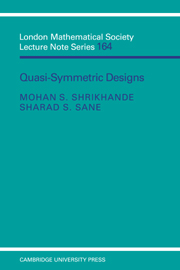Book contents
- Frontmatter
- Contents
- Preface
- Acknowledgments
- I Basic results from designs
- II Strongly regular graphs and partial geometries
- III Basic results on quasi-symmetric designs
- IV Some configurations related to strongly regular graphs and quasi-symmetric designs
- V Strongly regular graphs with strongly regular decompositions
- VI The Witt designs
- VII Extensions of symmetric designs
- VIII Quasi-symmetric 2-designs
- IX Towards a classification of quasi-symmetric 3-designs
- X Codes and quasi-symmetric designs
- References
- Index
IV - Some configurations related to strongly regular graphs and quasi-symmetric designs
Published online by Cambridge University Press: 05 May 2010
- Frontmatter
- Contents
- Preface
- Acknowledgments
- I Basic results from designs
- II Strongly regular graphs and partial geometries
- III Basic results on quasi-symmetric designs
- IV Some configurations related to strongly regular graphs and quasi-symmetric designs
- V Strongly regular graphs with strongly regular decompositions
- VI The Witt designs
- VII Extensions of symmetric designs
- VIII Quasi-symmetric 2-designs
- IX Towards a classification of quasi-symmetric 3-designs
- X Codes and quasi-symmetric designs
- References
- Index
Summary
If D is a quasi-symmetric design, then we know from Chapter III that its block graph is strongly regular. We have also seen that by imposing some extra structure on the block graph we can pin down the design D. To a quasi-symmetric design, we can associate some other naturally associated strongly regular graphs. Conversely, starting from a graph we may sometimes produce a design. If the graph г has some further structure, then in some cases the associated designs may have additional properties. We also enlarge the class of incidence structures under consideration and study graphs associated with partially balanced incomplete block designs with a two class association scheme. Partially balanced incomplete block designs are simply 1-designs with occurrences of point-pairs in blocks determined by adjacencies in the superposed strongly regular graph.
A restricted class of the partially balanced incomplete block designs (PBIBDs) is the class of special partially balanced incomplete block designs (SPBIBDs) which, in addition, satisfy a point-block regularity condition. A generalization of the notion of an SPBIBD is the notion of a partial geometric design of Bose, S.S. Shrikhande, and Singhi. The former structures were introduced by Bridges and M.S. Shrikhande in order to obtain a unified approach to many graph embedding problems considered earlier. A nice outcome of the linear algebraic techniques is the spectral characterization of partial geometric designs by Bose, Bridges, and M.S. Shrikhande.
Information
- Type
- Chapter
- Information
- Quasi-symmetric Designs , pp. 49 - 81Publisher: Cambridge University PressPrint publication year: 1991
